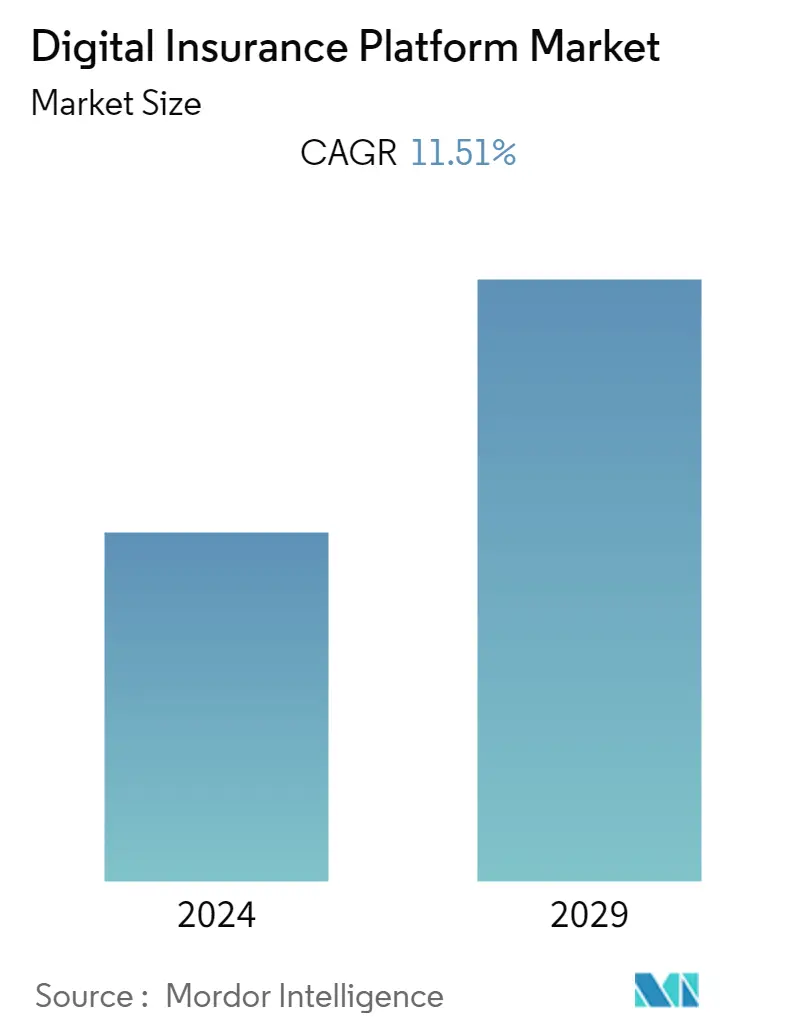Market Size of Digital Insurance Platform Industry

| Study Period | 2019 - 2029 |
| Base Year For Estimation | 2023 |
| CAGR | 11.51 % |
| Fastest Growing Market | North America |
| Largest Market | Asia Pacific |
| Market Concentration | Low |
Major Players
*Disclaimer: Major Players sorted in no particular order |
Need a report that reflects how COVID-19 has impacted this market and its growth?
Digital Insurance Platform Market Analysis
The Digital Insurance Platform Market was valued at USD 119.15 billion the previous year and is expected to grow at a CAGR of 11.51%, reaching USD 220.79 billion by the next five years. Insurtech companies are disrupting the insurance industry by building digital platforms and collaborating with insurance companies and suppliers. The paradigm shift from a product-centric model in traditional insurance companies to a primarily client-centric model has been enabled by the digital insurance platforms enabled by technologies like IoT, Big data analytics, blockchain, artificial intelligence, and cloud computing.
- Customer loyalty and satisfaction have become primary concerns for insurance companies. Artificial intelligence (AI) and related technologies are expected to significantly impact all aspects of the insurance value chain, from distribution to underwriting and pricing to claims management. This may result in policies being priced, purchased, and bound in near real-time. Through these, insurers have been able to smartly connect information and quickly deliver innovative products and services, which, in the end, will significantly improve customer loyalty and satisfaction.
- Signs of massive and unprecedented progress are observed across the insurance industry. Explore new technologies and partner with insurance companies and their existing technology partners to develop new models and tools. Others stimulate their business results by executing quick minimum viable products (MVPs), proof of concepts (POCs), and straight into production. Many seek ways to speed up their existing digital roadmaps during and post-pandemics. And some are exploring new outsourcing solutions to drive agility. Over the past few months, the market has focused on digitizing the contact centers and the claims functions. Notably, significant progress was made in adopting automation and process streamlining, improving the use of structured and unstructured data, external data, and the exploratory use of knowledge.
- On the flip side, the shift to digital insurance has increased the volume of data required and the variety of methods for processing it. When updating its catastrophe models, an insurance company, for instance, needs to know how many houses and businesses are vulnerable to manage risk and adjust its writings accordingly. In the future, a more comprehensive range of threats will need to be covered by catastrophe modeling. Further, insurance firms, particularly those who sell cyber insurance, have a specific obligation to protect their systems and data against hacking to manage risk and maintain the trust of their insured. Insurance providers require the appropriate procedures to manage their insured's information securely.
- Cloud computing allows insurance companies to scale their operations up or down quickly in response to changing business needs. This scalability and flexibility are crucial in handling fluctuations in customer demand and adapting to market changes.
- Integrating digital insurance platforms with the lagacy system is a common challange in the insurance industry and can restrain the growth of the digital insurance platform market. Several difficulties and complexities associated with this integration can hinder the adoption and implementation of modern digital solutions.
- The COVID-19 pandemic has simulated insurance companies to accelerate their digital transformation efforts. With lockdowns and social distancing measures in place, insurers had to find new ways to serve customers, manage claims, and conduct business remotly. This urgency drove increased investment in digital insurance platforms.
